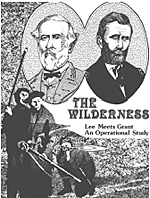
Components
1 12-page full size rulebook
1 22” x 28” large-hex map of the area in which the historical battle took place
200 die-cut counters
1 plastic box
Counter Manifest
81 Confederate counters (gray)
81 Union counters (blue)
31 markers (white)
6 randomizer chits (white)
1 turn marker (gray)
SimCan says:
“The Wilderness is a brigade level study of two days in May of 1864. The players are placed in the positions of the leaders of the opposing armies with leadership and command control systems modelled on the strengths and weaknesses of Civil War era command techniques as well as the influences of the participating individual commanders. Turns represent two hours of daylight and five hours of darkness. Hexes are scaled to 350 yards.”
The Reviewers say:
“The game uses the same system as Lee at the Crossroads and should be dismissed as more of the same number-crunching.” --Jamie Adams in F&M 96
“There have been very few simulations of this subject. This alone would give SimCan’s The Wilderness value. However, the system is a good one for simulating Civil War battles at this scale, and, while not easy to master, it is not particularly difficult to play.” --Nikita Frobish in the Grenadier 18.
“Somewhat awkward on bookkeeping and systems, but it works. ... Historically weak and lacking in the grit of tactics or the sweep of strategy. Either ignore the battle and play the system, or wait for somebody to do a better Wilderness game.” --David Cook in S&T 95
Collectors Notes
Boone lists low, high and average prices of 2/12/6.00 at auction and 8/25/16.50 for sale.
Comments
This game followed on from SimCan’s earlier Lee at the Crossroads design. A third game was to have been produced but was never published. The three together were to have shown the changes in the Union and Confederate army command and organization structures during the course of the war. Therefore, in The Wilderness there are elaborate rules for the command and control system (leaders taking orders, giving orders, promotions, injury and capture). It’s an old adage that a commander should work “two down”, that is, concern himself with the affairs of units and leaders no more than two levels of organization under his own, and I think this formula also holds true for a successful wargame (so a game where you are an army commander should not see you maneuvering anything less than a division at a time).
This game goes perhaps “three down”, with its five-level chain of leader promotions and replacements, but the small number of units involved overall does not make the game completely clumsy. There are not many games on The Battle of the Wilderness -- up to the publication of this game, only two other designs existed, both by SPI (The Wilderness Campaign, 1972, and one game in the rare Blue & Gray II Quad, 1976). Besides the involved command rules, there are sections on unit effectiveness, two kinds of assault, and chrome rules dealing with the thick bush that covered the battlefield -- it can be slashed down to give defensive fields of fire, ignited by gunfire, and burned out to smolder and perhaps ignite again. Casualties are tracked by a roster system, which provides a certain amount of limited intelligence, but the confused nature of the historical battle, which was a series of isolated ambushes and almost accidental firefights, might have been served better by a system of inverted counters.
Errata
There is no erratum for The Wilderness, but several people have mentioned the ability of the Union forces to block off the original entry hexes for the CSA and thus force them to enter on other roads with a turn delay. This was an historic possibility, so we did not want to prevent it. On top of which, when it was tried in playtest it tended to cause the Union to lose due to having an extremely stretched line from moving forward. Union command control is very difficult, even with a short line. So if you have the game, do not let this possibility bother you.
Steve Newberg says:
This game was an outgrowth of Lee at the Crossroads. The idea was to expand its very successful system to show how command structure changed over the course of the war. Lee at the Crossroads was the 1863 structure. The Wilderness was designed for the 1864 structure. It worked out well as history, and even reasonably well as a game, but I think the closed nature of the terrain hampered the players (as it did the participants!) We were going to do an 1862 game to cover the initial command structures, but never got to it.
Back to Simulacrum Vol. 3 No. 2 Table of Contents
Back to Simulacrum List of Issues
Back to MagWeb Master Magazine List
© Copyright 2001 by Steambubble Graphics
This article appears in MagWeb (Magazine Web) on the Internet World Wide Web. Other military history articles and gaming articles are available at http://www.magweb.com